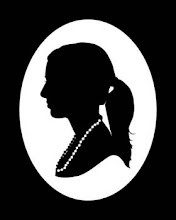
'A silhouette is a view of an object or scene consisting of the outline and a featureless interior, with the silhouetted object usually being black. The term was initially applied in the 18th century to portraits or other pictorial representations cut from thin black card.
The word silhouette is an eponym of Etienne de Silhouette, a French finance minister who in 1759 was forced by France's severe credit crisis during the Seven Years War to impose severe economic demands upon the French people, particularly the wealthy. Because de Silhouette enjoyed making cut paper portraits, his name became synonymous with these portraits and with anything done or made cheaply. Prior to the advent of photography, silhouette profiles cut from black card were the cheapest way of recording a person's appearance The advantage of the profile portrait is that, because it depends strongly upon the proportions and relationship of the bony structures of the face, forehead, nose and chin, the image is clear and simple, and deviates less from the appearance of the sitter with changes caused by age, weight and illness.
Profile portraits have been employed on coinage since the Roman era. The early Renaissance period saw a fashion for painted profile portraits and many famous people such as Lorenzo de Medici were depicted in profile. Recent research at Stanford University indicates that where previous studies of face recognition have been based on frontal views, studies with silhouettes show humans are able to extract accurate information about gender and age from the silhouette alone.This is an important concept for artists who design characters for visual media, because the silhouette is the most immediately recognizable and identifiable shape of the character. A silhouette portrait can be painted or drawn. However, the traditional method of creating silhouette portraits is to cut them from lightweight black cardboard, and mount them on a pale (usually white) background. This was the work of specialist artists, often working out of booths at fairs or markets. A traditional silhouette portrait artist would cut the likeness of a person, freehand, within a few minutes. Some modern silhouette artists also make silhouettes portraits from photographs of people taken in profile. The work of the physiologist Johanna Caspar Lavater, who used silhouettes to analyse facial types, is thought to have promoted the art.One of the most famous silhouette artists of the 18th century, August Edward, cut thousands of portraits in duplicate. His subjects included French and British nobility and US presidents. Much of his personal collection was lost in a shipwreck.In England, the best known silhouette artist was John Miers, who traveled and worked in different cities, but had a studio on the Strand in London. In America, silhouettes were highly popular from about 1790 to 1840. The invention of the camera signaled the end of the silhouette as a widespread form of portraiture.The skill was not lost, and traveling silhouette artists continued to work at state fairs into the 20th century.'
(from Wikipedia)




I collect silhouettes (well I have a small collection in my kitchen) and think that because of the black and white color scheme and abstraction of the portrait; that silhouette portraiture can compliment most interiors. I have also seen silhouettes come back as a big trend in home accessories, etc... Take a look at some current items:
 Totes from mothology
Totes from mothology  Plate from Thomas Paul
Plate from Thomas Paul Pillows from Ballard Designs
Pillows from Ballard Designs Hooks from Urban Outfitters
Hooks from Urban Outfitters


No comments:
Post a Comment